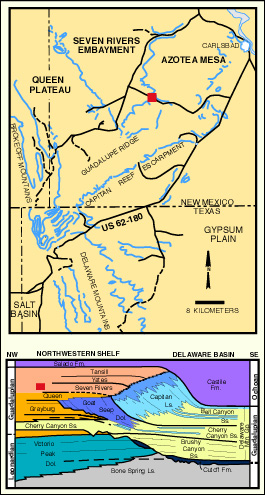
Permian Reef Complex Virtual Field Trip
Stop III-6: Seven Rivers Fm. Gypsum Deposits

Borrow pit in gypsum of Seven Rivers Formation. Surface weathering makes viewing of gypsum outcrops a frustrating exercise; most are altered to a very great degree with a solution residue covering most fabric elements. This borrow pit exposes the freshest samples easily accessible to a field trip group. Gray-white gypsum with a nodular, enterolithic texture (see photo) can be seen in isolated blocks scattered around the pit. This "chicken-wire" fabric may be related to a sabkha origin of the evaporite, but may also be a consequence of dehydration-rehydration reactions during burial and uplift (although the unit is gypsum on outcrop, it is generally anhydrite in the subsurface). The "chicken-wire" texture, with thin clay films between gypsum nodules, also been interpreted as the product of displacive growth of subaqueous gypsum in silty-clayey sediments in a shallow-water lagoon (Sarg, in Pray and Esteban, 1977). Other blocks show fine examples of gypsum rosettes (see photo). These clusters of crystals characterize bottom-nucleated gypsum growth from standing brine bodies in shallow salina settings.

© Peter A. Scholle, 1999

© Peter A. Scholle, 1999

© Peter A. Scholle, 1999
On the left, one can see a reentrant of the Seven Rivers Embayment, an extensive planar topographic feature developed by dissolution of the evaporites of the Seven Rivers Fm. The reddish hillslopes consist of silty redbeds with bedded or nodular gypsum (see photo) although these are very difficult to examine because the slopes typically are covered with a thick residue of evaporite dissolution.
Return to Dark Canyon-Sitting Bull Falls-Rocky Arroyo Roadlog


